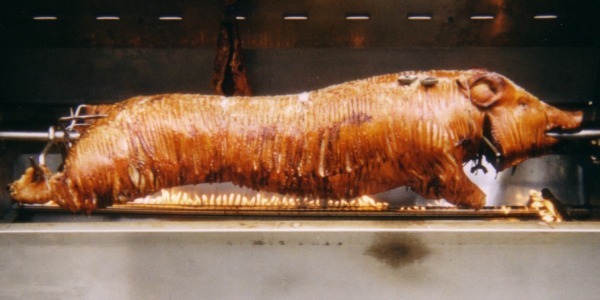-
Your shopping cart is empty!
Whole Hog Roasting
This is for information only. You can call us to order a pig. They come in cleaned ready fo roasting. FROZEN Call 321-242-3348 to order
Roasting a Hog in Three Steps
1) Buying your hog
- Order your pig from a specialty meat packer, grocery store or local locker. It is often necessary to give them 7 days advance notice. Before purchasing make sure the pig is absolutely clean.
- See Chart 2 for serving portions
- Dressed pigs are 70% of the live weight. Smaller animals will have a greater percentage of bone and skin and will yield proportionately fewer servings of meat.
- The carcass should be opened butterfly-fashion.
2) Equipment There are three methods for roasting a hog. Grill
- The temperature at the roast should be kept constant and around 200-250 degrees F.
- Most grills will have thermometers installed to monitor temperature. If not, use a large meat thermometer inserted in a top vent.
- The outside temperature, wind, type of equipment, all will have an effect on maintaining this temperature.
- Split the rib bones at the spine to allow pig to lay flat, being careful not to pierce skin.
- Fill grill with charcoal. (see Chart 1)
- Let charcoal burn until it has turned ash-grey.
- Place heavy wire, the size of the pig, over the grill, 13 inches from the coals.
- Place pig flat, skin side up on wire surface.
- Place second wire over pig, sandwiching pig between the 2 layers of wire
Rotisserie
- If using a rotisserie make sure weight is evenly distributed.
- Follow directions from your rotisserie manual.
Rock-lined Pit
- Dig hole 2 ½ to 3 feet deep at center with a diameter of 5 to 7 feet, depending on the size of the pig.
- Line the pit with rocks.
- Light fire.
- Additional small round rocks should be place in fire to be heated.
- As fire burns down, wet the burlap and dress pig as desired.
- Place pig on chicken wire.
- Under the legs make slits big enough to insert round heated rocks.
- When rocks are very hot, use tongs to fill the abdominal cavity and slits.
- Tie front legs together, then back legs.
- Wrap pig in chicken wire, fastening well so it can be lifted.
- Completely cover ashed coals and rocks with corn stalks and leaves or grass trimmings.
- Lower pig onto the leaves.
- Cover it generously on top with some leaves
- Place wet burlap over leaves to hold the heat and steam the pig.
- Cover with large canvas!!!
- Shovel dirt or gravel over canvas to keep steam in.
Chinese Box
The Chinese roasting box, also known as “La Caja China,” is a hot trend among barbecue enthusiasts. Contrary to the name, the device was invented by a Cuban American, Roberto Guerra Sanchez. In a Chinese roasting box, the hog is placed in a thick wooden box lined with sheet-metal and fitted with a removable pan in the bottom to catch cooking juices. Coals are piled on the box’s steel top to provide heat. The device is inspired by the American oven broiler with its heat source located above the food. The Chinese roasting box combines a broiling method with an enclosure reminiscent of the pit traditionally used in roasting hogs and other large meat cuts. The box cooks primarily by radiation. The box’s metal lining reflects the infrared radiation throughout the enclosure, similar to a microwave oven, so all the surfaces of the pig are heated, not just the top.
3) Cooking
- Hog is better if thawed.
Grill
- Because of variants in sizes, shapes, weights, air currents and methods of barbecuing, among others, it is difficult to give a rule of minutes per pound.
- For estimate grilling times see Chart 1.
- Always check the internal temperature with a meat thermometer.
- Once the internal temperature reaches 160 degrees F, the roast should be removed.
- A good place to check is the ham, as it is the largest section of the hog.
- Turn hog over half way through cooking process.
- ***Time is a variant! One must be flexible in the timing and cooking process, checking the hog often is essential.
Rotisserie
- Cook the pig 12” away from the source of heat.
- Keep the heat constant.
- Fluctuating heat will add to your cooking time.
- 110 pound live weight estimated cooking time is 8-10 hours.
- When pig reaches 160 degrees F move the pig away from the heat.
- An estimated 1-2 hours will keep the pig warm without drying out.
- ***Time is a variant! One must be flexible in the timing and cooking process, checking the hog often is essential.
Rock-lined Pit
- Estimated cooking times 2 hours for 25 pound live weight 2 ½ hours for 50 pound live weight 4 hours for 75 pound live weight 8 hours for 150 pound live weight
- When in doubt, leave it in the pit a big longer. The pig will not burn as it is cooked by the steam.
- Start cooking 12 hours ahead of serving time depending on the above table, periodically checking internal temperature.
- When pig reaches 160 degrees F move the pig away from the heat.
- An estimated 1-2 hours will keep the pig warm without drying out.
- ***Time is a variant! One must be flexible in the timing and cooking process, checking the hog often is essential.
Chart 1
|
Weight of Pig |
Charcoal |
Amount of Gas |
Wood |
Cooker Temperature |
Estimated Cooking Time with Closed Lid |
|
75 lbs |
60 lbs |
40 lbs. Cylinder |
1/3 Cord |
225-250 |
6 to 7 hours |
|
100 lbs. |
70 lbs |
40 lbs. Cylinder |
1/3 - 1/2 Cord |
225-250 |
7 to 8 hours |
|
125 lbs. |
80 lbs. |
40 lbs. Cylinder |
1/2 Cord |
225-250 |
8 to 9 hours |
Chart 2 Estimating serving sizes from dressed pig.
|
75 lbs. dressed pig: |
30 lbs. cooked, chopped pork |
|
100 lbs. dressed pig: |
40 lbs. cooked, chopped pork |
|
125 lbs. dressed pig: |
50 lbs. cooked, chopped pork |
|
14 lbs. uncooked shoulder: |
10 lbs. cooked |
|
6-7 lbs. uncooked Boston Butt: |
3 lbs. cooked |
|
14 lbs. uncooked ham: |
6-7 lbs. cooked |
A good estimate is 1 ½ lbs serving size per person





